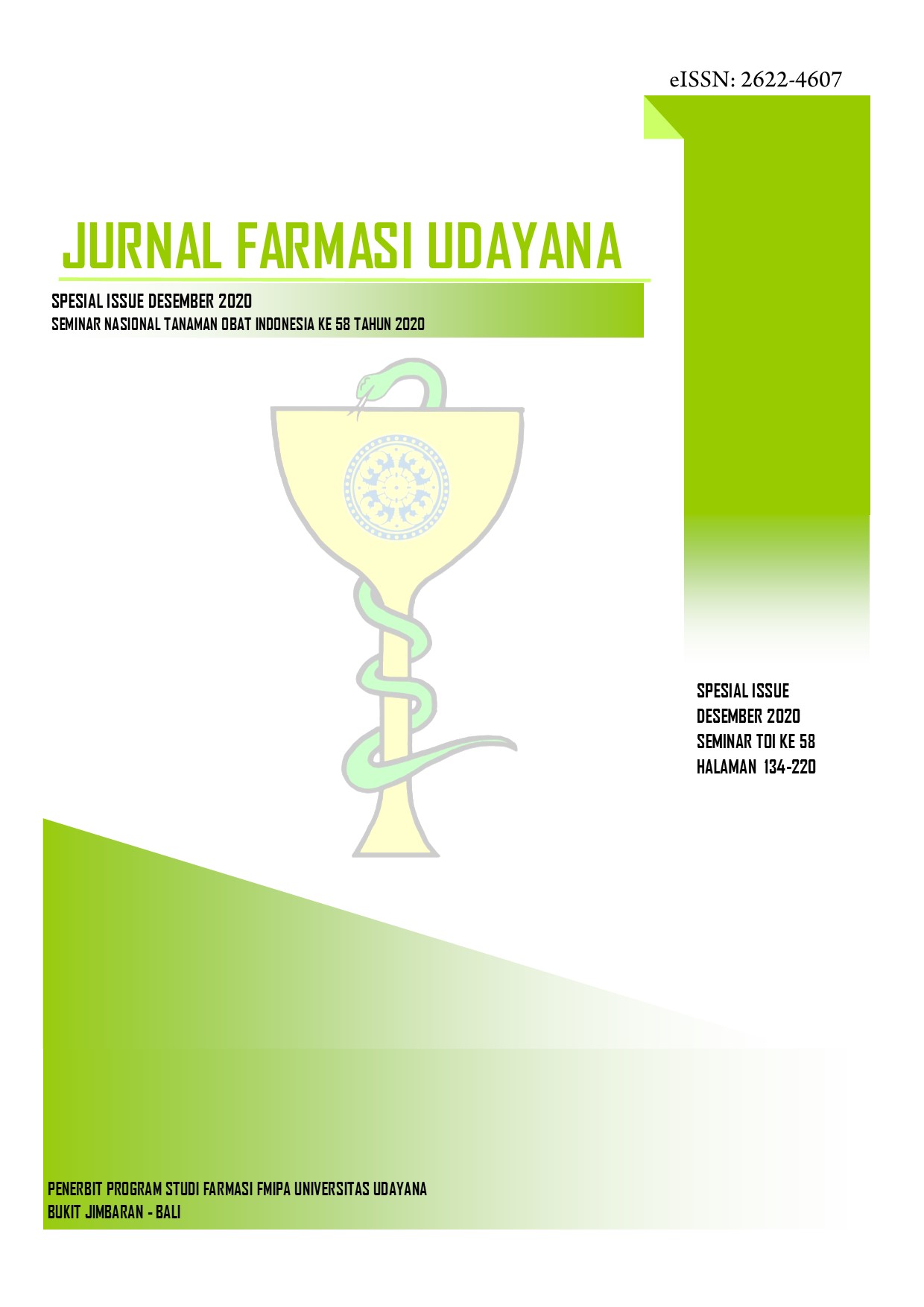The Potential Antioxidant Of Nanoparticle Of Limus (Mangifera foetida Lour) Seed Kernel Extract
Abstract
The antioxidants are compounds that have the ability to inhibit free radical activity that causes degenerative diseases. One source of natural ingredients known to have antioxidant activity is limus (Mangifera foetida Lour.), One of mango species from the Anacardiaceae tribe which is a local Indonesian fruit. Limus seed kernel extract (EBL) has been shown to have antioxidant activity. Antioxidant activity can be increased by making nanoparticle preparations. This study aims to increase the antioxidant activity of limus seeds by modifying the extract into nanoparticle preparations. The preparation of nanoparticles was carried out by the ionic gelation method and to ensure the formation of extract nanoparticles, characterization was carried out including particle size, polydispersion index and zeta potential value. The increase in antioxidant activity of limus seed extract (NEBL) nanoparticles was carried out by comparing the IC50 value with the IC50 EBL value, and to see its potential by comparing it with vitamins. The method of measuring antioxidant activity used is the DPPH (2,2-diphenyl-1-picrylhydrazyl) method. IC50 data were analyzed using the One Way Annova test and post-hoc LSD test with a confidence level of 95%. Based on the research results, it was obtained that limus seed extract nanoparticles were prepared which had characteristics including; The particle size was 2.91 nm, the polydispersion index value was 0.456 and the zeta potential value was +56 mV and the IC50 value was 1.166 ± 0.021 µg/mL. The IC50 value of the EBL is 9.127 ± 0.022 µg/mL and Vitamin C is 3.933 ± 0.013. µg/mL Modification of EBL into NEBL preparations can increase antioxidant activity and has excellent potential as a natural antioxidant because it has stronger antioxidant activity than vitamin C (p <0.05).
Keywords: Antioxidant, Limus, Mangifera foetida Lour, Nonoparticle
Downloads
References
Agoes, Goeswin. (2008). Sistem Penghantaran Obat Pelepas Terkendali. Bandung: ITB Press.
Atun, Sri dan Sri Handayani. (2017). Synthesis of Nanoparticles Produced by Ethanol Extract of Boesenbergia rotunda Rhizome Loaded with Chitosan and Alginic Acid and its Biological Activity test. Pharmacogn J. 2017; 9 (2): 142-147. doi.org/10.5530/pj.2017.2.24
Biswas, AK, MDR Islam, ZS Choudhury, S Mostofa, MF Kadir . (2014). Nanotechnology Based Approaches in Cancer Therapeutics. Adv. Nat. Sci; 5(4): 1-11. doi.org/10.1088/2043-6262/5/4/043001
Hanani, Endang. (2016). Analisi Fitokimia. Jakarta: EGC.
Harborne. (1987). Metode Fitokimia Penuntun Cara Modern Menganalisis Tumbuhan, Edisi kedua, Hal 5, 69-76, diterjemahkan oleh Kosasih Padmawinata dan Iwang Soedira, ITB Press, Bandung.
Kurniasih M, P Purwati, RS Dewi, S Fatimah. (2018). Uji Aktivitas Antioksidan N-Metil Kitosan Berkelarutan Tinggi. ALCHEMY Jurnal Penelitian Kimia; 14(1): 107-118. doi.org/10.20961/alchemy.14.1.15100.107-118
Mappamasing F, E Anwar, A Mun’im. (2015). Formulasi, Karakterisasi dan Uji Penetrasi In Vivo Resveratrol Solid Lipid Nanopartikel dalam Krim Topikal. Jurnal Ilmu Kefarmasian Indonesia; 13(2): 137-144.
Mulangsri DAK, A Budiarti, EN Saputri. (2017). Aktivitas Antioksidan Fraksi Dietileter Buah Mangga Arumanis (Mangifera indica L.) dengan Metode DPPH. Jurnal Pharmascience; 04 (01): 85 – 93. doi.org/10.20527/jps.v4i1.5760
Munawar A, Mohammed, JTM Syeda, KM Wasan, EK Wasan. (2017). An Overview of Chitosan Nanoparticles and Its Application in Non-Parenteral Drug Delivery. Pharmaceutis 2017; 9 (53): 1-26. doi.org/10.3390/pharmaceutics9040053
Nidhin, M, Sreeram K. J, Indumathy R dan Nair B U. (2008). Syntesis Of Iron Oxide Nanoparticles Of Narrow Size Distribution On Polysaccharide Templates. Bulletin of Materials Science, 31(1), 93-96. https://doi.org/10.1007/s12034-008-0016-2
Nurkhasanah, Tedjo Yuwono, Laela Hayu Nurani, Muhammad Ikhwan Rizki, Krisana Kraisintu. (2015). The Development of Chitosan Nanoparticles From Hibiscus Sabdariffa L Calyx Extract From Indonesia And Thailand. IJPSR; 6(5): 1855-1861. DOI: 10.13040/IJPSR.0975-8232.6(5).1855-61
Nurviana, Vera. (2016). Profil Farmakognosi dan Skrining Fitokimia dari Kulit, Daging, dan Biji Buah Limus (Mangifera foetida Lour). Jurnal Kesehatan Tunas Husada; 16 (1): 136-142. doi.org/10.36465/jkbth.v16i1.176
Nurviana V, AY Aprilia, EK Nuraini. (2018). Skrining Aktivitas Antioksidan Fraksi Ekstrak Etanol Kernel Biji Limus. Pharma Xphore; 3(2): 216-223.
Pate, K, P. Safier. (2016). Chemical Metrology Methods for CMP Quality. Elsevier, 299-325. https://doi.org/10.1016/B978-0-08-100165-3.00012-7
Sagar, B.K., Singh, R.P. (2011). Genesis and development of DPPH method of antioxidant assay. JFood Sci
Taurina W, R Sari, UC Hafinur, S Wahdaningsih, Isnindar. (2017). Optimasi Kecepatan Dan Lama Pengadukan Terhadap Ukuran Nanopartikel Kitosan-Ekstrak Etanol 70% Kulit Jeruk Siam (Citrus Nobilis L.Var Microcarpa). Trad. Med. J., January; 22(1): 16-20. doi.org/10.22146/tradmedj.24302
Widayani, Anis, Edy Cahyono, Harjono. (2018). Isolasi dan Uji Antioksidan Minyak Atsiri Daun Sirih Merah (Piper crocatum Ruiz dan Pav.) pada Minyak Goreng Curah. Indonesian Journal of Chemical Science: 7(3); 214-220.
Weng, Xin Chu dan Michael H. Gordon. (1992). Antioxidant Activity of Quinones Extracted from Tanshen (Salvia miltiorrhiza Bunge). J. Agric. Food Chem: 40 (8); 1331-1336. doi.org/10.1021/jf00020a007




